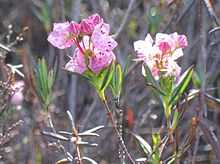Kalmia polifolia
From Wikipedia, the free encyclopedia
| Kalmia polifolia | |
|---|---|
 | |
| Scientific classification | |
| Kingdom: | Plantae |
| (unranked): | Angiosperms |
| (unranked): | Eudicots |
| (unranked): | Asterids |
| Order: | Ericales |
| Family: | Ericaceae |
| Genus: | Kalmia |
| Species: | K. polifolia |
| Binomial name | |
| Kalmia polifolia Wangenh. | |
| Synonyms | |
|
Chamaedaphne glauca[citation needed] | |
Kalmia polifolia, commonly called bog-laurel or swamp laurel,[1] is an evergreen shrub of cold acidic bogs, in the family Ericaceae. It is native to north-eastern North America, from Newfoundland to Hudson Bay southwards.
Its leaves are arranged oppositely on the branch. They are waxy with an entire, revolute margin. The base of the petiole is pressed against the stem. Below each leaf base there are ridges, where it appears as though a part of the leaf is curled around the circumference of the stem. This is especially noticeable lower on the plant.
Bog-laurel contains grayanotoxin, which when ingested lowers blood pressure, and may cause respiratory problems, dizziness, vomiting, or diarrhea.[2]
References
- ↑ "USDA GRIN Taxonomy".
- ↑ Jim Pojar and Andy MacKinnon, ed. (2004). Plants of the Pacific Northwest Coast (in English language) (Revised ed.). Vancouver: Lone Pine Publishing. p. 53. ISBN 978-1-55105-530-5.
|coauthors=requires|author=(help)
External links
This article is issued from Wikipedia. The text is available under the Creative Commons Attribution/Share Alike; additional terms may apply for the media files.